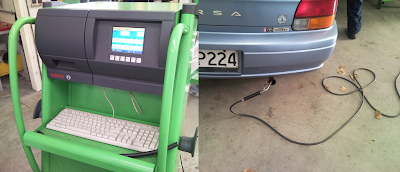WS7 Exhaust Gas Analysis (Petrol only)
Make TOYOTA Model CORSA Year 1996
Exhaust Analyser should be warmed up and recently calibrated. When it’s time to start taking tailpipe readings, put the analyser probe into the tailpipe and install exhaust tube over probe to capture exhaust fumes. Make sure there is adequate ventilation.
Note: make sure you fill out the “means: ............. segment to explain what that gas reading means. Example, if you are measuring HC, which shows us about misfire in the engine, and you had a low number like 28 ppm, you would say “shows low amount of misfire”, or “most of the fuel is being burnt.” But if the HC was high, like 340 ppm, you might say “There is a high amount of misfire” or “not all the fuel is being burnt.”
1. With the analyser probe sensing normal air, what are the Four Gas readings? Record the amount and then what it means:
CO 0.001% means: control rich conditions
HC 12 ppm means: higher HC means that unburn fuel remains in the exhaust gases.
CO2 0.00% means: efficency
O2 20.9% means: lean
2. Start the engine idling cold, and record the Four Gas readings:
Explain what is happening within the engine referring to the four gases:
CO 2.5% HC 788ppm CO2 12.6% O2 5.15%
When the engine starts with cold idle conditions, the CO increase to 2.5%. This means that rich mixture enters the combustion chamber. The HC also goes up significantly and unburn fuel remains in the exhaust gases. The CO2(efficency) is low and the O2 is high from the inactive catalytic converter.
3. When the engine has warmed up, record the Four Gas readings:
Explain what is happening within the engine referring to the four gases:
CO 0.001% HC 29ppm CO2 15.01% O2 0.40%
When the engine is fully warmed up, the CO and HC noticablely decrease. This means that ideal mixture enters the combustion chamber. The CO2(efficency) is high and the O2 is low because the catalytic conver well operates for cleaning the emissions.
4. Run the warm engine at 2500 RPM, record the Four Gas readings:
Explain what is happening within the engine referring to the four gases:
CO 0.23% HC 121ppm CO2 15.10% O2 0.32%
When the warm engine is run at 2500 rpm, the CO and HC are more produced than the engine idling due to higher rpm with more emissions. However, the CO2 and O2 are still similar to idling condition.
5. At idle, run the mixture rich with extra propane, LPG, or carburettor cleaner, and record the Four Gas readings:
Explain what is happening within the engine referring to the four gases:
CO 0.96% HC 224ppm CO2 14.32% O2 0.68%
At idle, I made a disconnection of the vacuum hose in the fuel regulator for the rich condition. The CO increases to 0.96% which means the state of rich mixture. The unburn fuel is more produced due to more fuel injection.
6. At idle, create a lean condition with an air leak or vacuum leak, record the Four Gas readings:
Explain what is happening within the engine referring to the four gases:
CO 0.029% HC 470ppm CO2 7.79% O2 5.93%
At idle, I made a disconnection of the PCV valve for the lean condition. The CO recovers the nomal condition. The unburn fuel goes up at 470ppm. The CO2(efficency) is reduced but the O2 increases significantly which means the state of lean mixture.
7. Accelerate the engine, by blipping the throttle a few times (don’t rev too high anddamage the engine), and watch how the gas readings change. Record the Four Gas readings when the CO is highest:
Explain what is happening within the engine referring to the four gases:
CO 2.5% HC 434ppm CO2 10% O2 1.3%
From the sudden acceleration, the rich mixture is supplied into the combustion chamber. The CO and HC rise. The CO2(efficency) is reduced but the O2 increases slightly due to more fuel injection with more intake air.
8. Disconnect one spark plug wire, ground it with a jumper wire, then record the Four Gas readings as the engine idles:
Explain what is happening within the engine referring to the four gases:
CO 0.01% HC 1033ppm CO2 13.6% O2 4.53%
When the misfire is produced in a cylinder, the HC increases dramatically because the unburn fuel is created by the misfired cylinder. The O2 is also produced more from the air/fuel mixture of the misfired cylinder.
9. If you can get to it, disconnect the injector harness connector from one injector on an engine that has one injector for every cylinder: Record the Four Gas readings as the engine idles:
Explain what is happening within the engine referring to the four gases:
CO 0% HC 55ppm CO2 11.61% O2 5.45%
When the injector is disconnected, the HC is normal because the fuel does not injects into the intake port. However, the O2 increases due to the air is still supplied into the combustion chamber.
10. Optional: Make other changes to the engine at idle, such as turning on the air conditioning or rocking the steering wheel. Note the change you made:
Explain what is happening within the engine referring to the four gases:
CO 0.009% HC 18ppm CO2 15.44% O2 0.04%
Overall, the emission is clean with proper values. However, when loads (air conditioning and rocking the steering wheel) are added, the rpm will go up. As a result , the CO and HC increase slightly with the rich condition.
Return the vehicle to good condition and proper adjustment.
11. Explain the different readings you would get from a vehicle with a catalytic converter and a vehicle without one and why?
I would get the differnt readings. If the vehicle does not have a catalytic converter the emission will be exhausted without any filtering. The catalytic converter helps reducing emissions with its chemical actions.
12. Explain what light off point means and what happens?
When the temperature is hot enugh, the catalytic converter will clean the emissions with its operating temperature.
13. On lambda, 02 sensors why do they have 1,2,3,4 or 5 wires and what do these extra wires do?
From two white heater positive and negative, the O2 sensor works correctly and increases responses with operating temperature when the engine starts with cold conditions. The black wire is a snesor signal positive which gives the state of exhaust gases to the ECU. The gray wire is a sensor signal earth.
Subscribe to:
Post Comments (Atom)


No comments:
Post a Comment